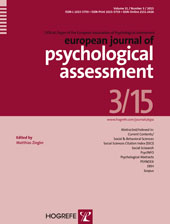General and Specific Avoidance
The Development and Concurrent Validation of a New Measure of Avoidance Coping
Abstract
Abstract. Research on coping has been hampered by psychometric shortcomings in coping scales, which have typically relied on items based on face-value, extracted too many factors or lacked the evidence for the obtained structure from confirmatory factor analysis. The present paper describes the development and concurrent validation of a new three-factor avoidance coping scale, the General and Specific Avoidance Questionnaire (GSAQ), which comprises General Avoidance, Emotional Avoidance, and Conflict Avoidance. In contrast to earlier scales the items were derived from a scenario technique which elicits items from participants’ experience, and the three-factor structure was endorsed by two confirmatory factor analyses on independent samples and a further exploratory factor analysis based on the total pooled sample of participants from all three analyses. Factor correlations indicate that the scales measure discrete facets of the avoidance coping domain, and while concurrent validation showed that General and Conflict Avoidance were related in predictable ways to criterion measures, the pattern for Emotional Avoidance was unexpected.
References
(2002). The effects of item parcelling on goodness-of-fit and parameter estimate bias in structural equation modelling. Structural Equation Modelling, 9, 78–102.
(2011). Religion, ethnicity, coping style, and self-reported self-harm in a diverse non-clinical UK population. Mental Health, Religion & Culture, 14, 259–269.
(2006). Confirmatory factor analysis for applied research. New York, NY: Guilford Press.
(1997). Psychometric properties of the Depression Anxiety Stress Scales (DASS) in clinical samples. Behavior Research and Therapy, 35, 79–89.
(1993).
Alternative ways of assessing model fit . In K. A. BollenJ. S. LongEds., Testing structural equation models, (pp. 136–162). Newbury Park, CA: Sage.(1989). Assessing coping strategies: A theoretically based approach. Journal of Personality and Social Psychology, 56, 267–283.
(2007). The construction and validation of a scale to assess psychological risk and well-being in sex offender treatment providers. Legal and Criminological Psychology, 12, 83–100.
(2011). The mediation effect of experiential avoidance between coping and psychopathology in chronic pain. Clinical Psychology and Psychotherapy, 18, 34–47.
(2005). Best practices in exploratory factor analysis: Four recommendations for getting the most from your analysis. Practical Assessment, Research & Evaluation, 10, 1–9.
(2003). The Depression Anxiety Stress Scales (DASS): Normative data and latent structure in a large non-clinical sample. British Journal of Clinical Psychology, 42, 111–131.
(1998). Thought suppression produces a rebound effect with analogue post-traumatic intrusions. Behaviour Research and Therapy, 36, 571–582.
(1990). Multidimensional assessment of coping: A critical evaluation. Journal of Personality and Social Psychology, 58, 844–854.
(1985). If it changes it must be a process: Study of emotion and coping during three stages of a college examination. Journal of Personality and Social Psychology, 48, 150–170.
(1999). Stress, social support and fear of disclosure. British Journal of Health Psychology, 4, 165–179.
(1992). The relationship of dispositional optimism, daily life stress, and domestic environment to coping methods used by cancer patients. Journal of Behavioral Medicine, 15, 127–141.
(2011). Development of a measure of experiential avoidance: The Multidimensional Experiential Avoidance Questionnaire. Psychological Assessment, 23, 692–713.
(1999, July 12–14). The Proactive Coping Inventory (PCI): A multidimensional research instrument, Paper presented at the 20th International Conference of the STAR (Stress and Anxiety Research Society), Cracow, Poland.
(1996). Experiential avoidance and behavioral disorders: A functional dimensional approach to diagnosis and treatment. Journal of Consulting and Clinical Psychology, 64, 1152–1168.
(2002). To parcel or not to parcel: Exploring the question, weighing the merits. Structural Equation Modelling, 9, 151–173.
(1995). Manual for the Depression Anxiety Stress Scales. Sydney, Australia: Psychology Foundation.
(2000). A psychometric re-assessment of the COPE questionnaire. Personality and Individual Differences, 29, 321–335.
(2004). Gender differences in stress and coping styles. Personality and Individual Differences, 37, 1401–1415.
(2009). Coping with fear through suppression and avoidance of threatening information. Journal of Experimental Psychology: Applied, 15, 258–274.
(2000). SPSS and SAS programs for determining the number of components using parallel analysis and Velicer’s MAP test. Behavior Research Methods, Instruments & Computers, 32, 396–402.
(2004). Avoidance and depression: The construction of the cognitive-behavioral avoidance scale. Behaviour Research and Therapy, 42, 293–313.
(2004). The measurement of coping responses: Validity of the Billings and Moos Coping Checklist. Journal of Psychosomatic Research, 57, 477–484.
. (2004). Handbook of research methods in industrial and organizational psychology. Oxford, UK: Blackwell Publishing.
(1996, July). The role of cognitive rumination, coping styles and self-esteem in moderating the adaptational responses to stress, Paper presented at the 8th European Conference on Personality, University of Ghent.
(2011). Rumination, inhibition and stress: The construction of a new scale for assessing emotional style. Current Psychology, 30, 234–244.
(1993). Detachment and coping: The construction and validation of a new scale for measuring coping strategies. Personality and Individual Differences, 15, 619–626.
(1998). The relationship between emotional rumination and cortisol secretion under stress. Personality and Individual Differences, 24, 531–538.
(2010). Some guidelines concerning the modeling of traits and abilities in test construction. European Journal of Psychological Assessment, 26, 1–2. doi: 10.1027/1015-5759/a000001
(2008). The Cognitive Avoidance Questionnaire: Validation of the English translation. Journal of Anxiety Disorders, 22, 355–370.
(1997). Coping strategies: Evidence for cross-cultural differences? A preliminary study with the Italian version of Coping Orientations to Problems Experienced (COPE). Personality and Individual Differences, 23, 1025–1029.
(1998). Development of four self-report measures of job stressors and strain: Interpersonal Conflict at Work Scale, Organizational Constraints Scale, Quantitative Workload Inventory, and Physical Symptoms Inventory. Journal of Occupational Health Psychology, 3, 356–367.
(2012). A longitudinal study relating workplace abuse to physical and psychological strains, Paper presented at the Southern Management Association Conference, Fort Lauderdale, FL, USA, October 30–November 3, 2010.
(1998). A critique of coping scales. Australian Psychologist, 33, 193–202.
(1985). The relative efficacy of avoidant and nonavoidant coping strategies: A meta-analysis. Health Psychology, 4, 249–288.
(2004). Negative thoughts and health: Associations among rumination, immunity, and health care utilization in a young and elderly sample. Psychosomatic Medicine, 66, 363–371.
(1987). Paradoxical effects of thought suppression. Journal of Personality and Social Psychology, 53, 5–13.



